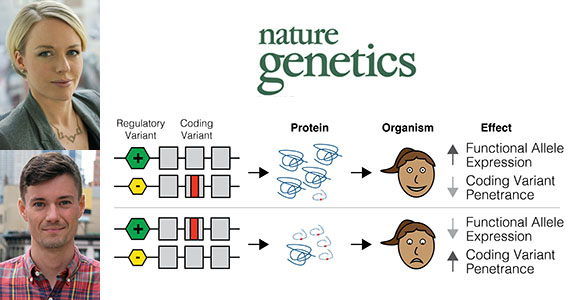
Tuuli Lappalainen (top photo) and Stephane Castel co-led the new study. The hypothesis of the study is illustrated here with an example in which an individual is heterozygous for both a regulatory variant and a pathogenic coding variant. The two possible haplotype configurations would result in either decreased penetrance of the coding variant, if it was on the lower-expressed haplotype, or increased penetrance of the coding variant, if it was on the higher-expressed haplotype. (Composite image courtesy of NYGC)
Researchers at the New York Genome Center (NYGC) and Columbia University's Department of Systems Biology have uncovered a molecular mechanism behind one of biology’s long-standing mysteries: why individuals carrying identical gene mutations for a disease end up having varying severity or symptoms of the disease. In this widely acknowledged but not well understood phenomenon, called variable penetrance, the severity of the effect of disease-causing variants differs among individuals who carry them.
Reporting in the Aug. 20 issue of Nature Genetics, the researchers provide evidence for modified penetrance, in which genetic variants that regulate gene activity modify the disease risk caused by protein-coding gene variants. The study links modified penetrance to specific diseases at the genome-wide level, which has exciting implications for future prediction of the severity of serious diseases such as cancer and autism spectrum disorder.
NYGC Core Faculty Member and Systems Biology Assistant Professor Dr. Tuuli Lappalainen, PhD, led the study alongside post-doctoral research fellow Dr. Stephane Castel.
